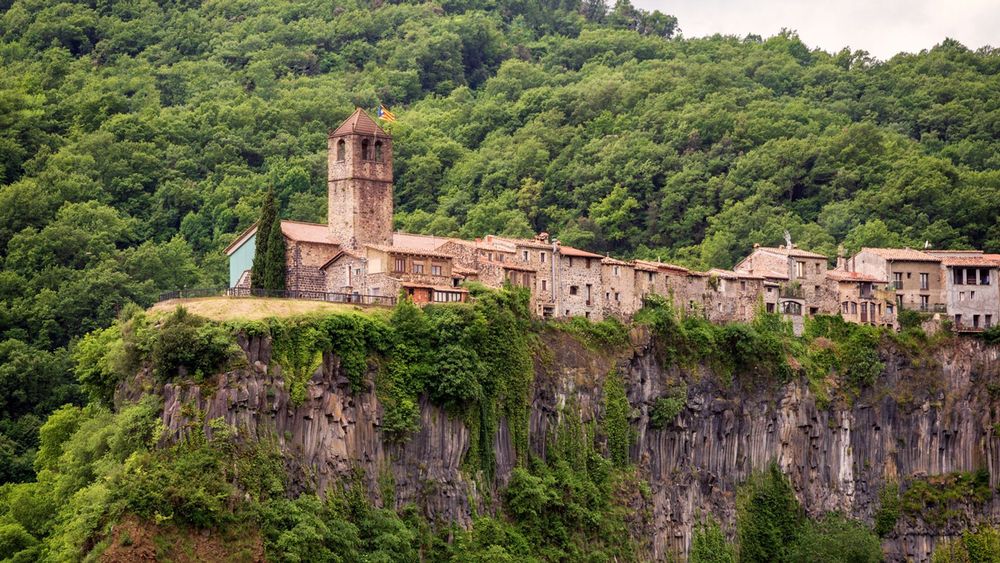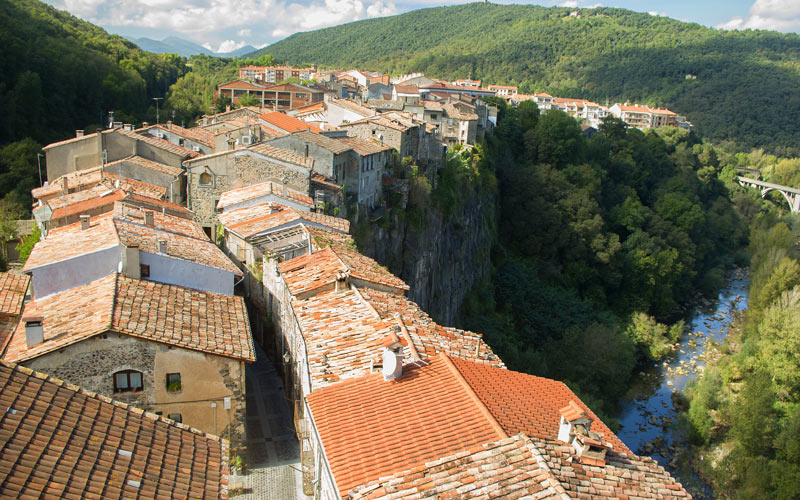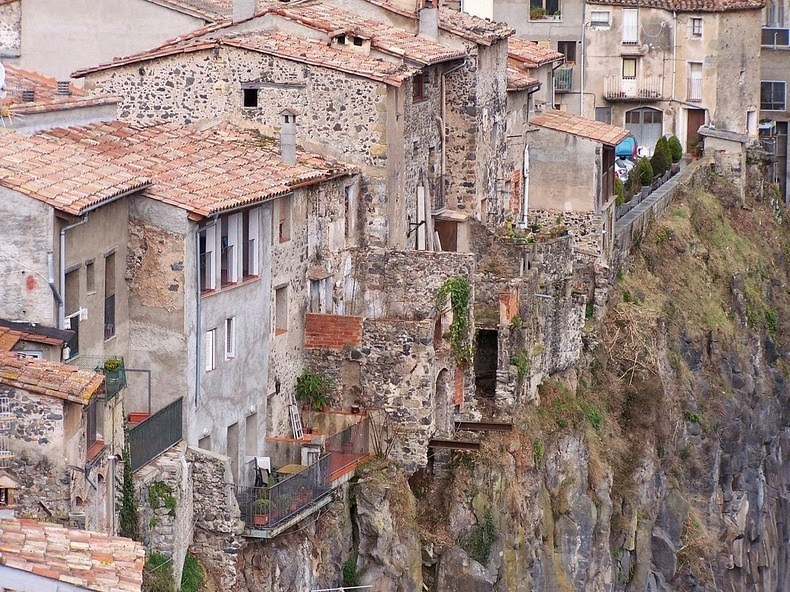Introduction
Nestled in the heart of the Garrotxa volcanic zone in Catalonia, Spain, lies a captivating village that defies the imagination. Castellfollit de la Roca is a true marvel of nature, perched precariously atop a towering basalt crag that rises over 50 meters (160 feet) high and stretches nearly a kilometer long. This stunning geological formation, the result of ancient volcanic activity, provides the village with a breathtaking setting that leaves visitors in awe.

But Castellfollit de la Roca is more than just a natural wonder; it is a place that embodies the rich cultural and historical tapestry of the Catalan region. As you wander through its narrow streets and admire the traditional Catalan architecture, you’ll be transported to a bygone era, where the echoes of the past whisper stories of resilience, tradition, and the enduring spirit of the Catalan people.
In this blog post, we’ll delve into the captivating world of Castellfollit de la Roca, exploring its geological marvels, its historical significance, and the unique cultural experiences that await visitors who venture to this remarkable village perched on the edge of a cliff.
The Geological Masterpiece of Castellfollit de la Roca
The dramatic setting of Castellfollit de la Roca is a testament to the incredible power of nature and the forces that have shaped the Earth over millions of years. The village’s iconic basalt crag is a product of the region’s volcanic history, which has left an indelible mark on the landscape.
The Garrotxa volcanic zone, where Castellfollit de la Roca is located, is one of the most active volcanic regions in the Iberian Peninsula. This area has been shaped by a series of volcanic eruptions that occurred over the course of several millennia, creating a diverse and visually stunning landscape.
The basalt crag that supports the village of Castellfollit de la Roca is a particularly remarkable feature of this volcanic landscape. Basalt is a type of igneous rock that is formed when lava cools and solidifies, and the crag itself is the result of a massive lava flow that occurred during a volcanic eruption thousands of years ago.

As the lava cooled, it contracted and cracked, forming the distinctive columns and ridges that now make up the crag. The sheer height and length of the crag are truly awe-inspiring, and it’s easy to see why the village perched atop it has become such a popular destination for visitors from around the world.
One of the best ways to appreciate the geological wonder of Castellfollit de la Roca is to take a stroll along the village’s scenic viewpoints, which offer breathtaking panoramic vistas of the surrounding landscape. From these vantage points, you can see the dramatic drop-off of the basalt crag, as well as the winding Fluvià River that flows through the valley below.

But the geological significance of Castellfollit de la Roca extends beyond just the crag itself. The village is also situated within the Garrotxa Volcanic Zone Natural Park, a protected area that is home to a diverse array of volcanic features, including cones, craters, and lava flows. Visitors can explore these geological wonders through a network of hiking trails that wind through the park, offering a unique opportunity to delve into the region’s rich volcanic history.
The Historical and Cultural Significance of Castellfollit de la Roca
While the natural beauty of Castellfollit de la Roca is undoubtedly the main draw for many visitors, the village also boasts a rich and fascinating history that is inextricably linked to the Catalan region.
The earliest recorded history of Castellfollit de la Roca dates back to the 9th century, when the village was first mentioned in historical documents. At that time, the area was part of the Catalan counties that were under the rule of the Frankish Empire, and the village played a strategic role in the defense of the region.

Over the centuries, Castellfollit de la Roca has weathered many political and social upheavals, from the Catalan Revolt against the Spanish monarchy in the 17th century to the Spanish Civil War in the 1930s. Despite these challenges, the village has remained a stronghold of Catalan culture and identity, with its traditional architecture, customs, and language serving as a testament to the resilience and pride of the Catalan people.
One of the most iconic symbols of Castellfollit de la Roca’s cultural heritage is its traditional Catalan architecture. As you wander through the village’s narrow streets, you’ll be struck by the charming, whitewashed buildings with their distinctive red-tiled roofs and wrought-iron balconies. Many of these buildings date back to the 18th and 19th centuries, and they reflect the unique blend of Catalan and Mediterranean influences that have shaped the region’s architectural style.

In addition to its architectural heritage, Castellfollit de la Roca is also home to a number of cultural and historical sites that offer visitors a glimpse into the village’s past. One of the most notable is the Church of Sant Salvador, a Romanesque-style church that dates back to the 12th century. The church’s imposing bell tower and ornate façade are a testament to the region’s rich religious history and the importance of the Catholic faith in Catalan culture.
Another must-see attraction in Castellfollit de la Roca is the town’s historic center, which has been meticulously preserved and is now a designated UNESCO World Heritage site. As you wander through the winding streets and alleyways, you’ll be transported back in time, with the sound of Catalan voices and the aroma of traditional Catalan cuisine filling the air.

But the cultural significance of Castellfollit de la Roca extends beyond just its physical landmarks and historical sites. The village is also known for its vibrant festivals and cultural events, which celebrate the rich traditions and customs of the Catalan people.
One of the most popular events is the Festa Major, a week-long celebration that takes place every August. During this festival, the village comes alive with music, dance, and traditional Catalan cuisine, as locals and visitors alike come together to honor the community’s heritage and identity.
Another cultural highlight is the annual Fira de Sant Lluc, a traditional fair that takes place in October. This event features a variety of local artisanal products, from handcrafted pottery and textiles to traditional Catalan delicacies, offering visitors a unique opportunity to immerse themselves in the region’s rich cultural heritage.
Exploring the Captivating Village of Castellfollit de la Roca
With its stunning natural setting, rich history, and vibrant cultural traditions, Castellfollit de la Roca is a truly captivating destination that offers visitors a unique and unforgettable experience.
Whether you’re drawn to the village’s geological marvels, its historical significance, or its cultural heritage, there is something for everyone to discover in this remarkable corner of Catalonia.

One of the best ways to explore Castellfollit de la Roca is to simply wander through its charming streets and alleyways, taking in the sights, sounds, and smells of traditional Catalan life. As you stroll, be sure to keep an eye out for the village’s iconic basalt crag, which looms over the landscape like a natural fortress.
For those who want to delve deeper into the region’s geological history, a visit to the Garrotxa Volcanic Zone Natural Park is a must. Here, you can hike through the park’s network of trails, exploring the diverse array of volcanic features and learning more about the forces that have shaped this remarkable landscape.

In addition to its natural wonders, Castellfollit de la Roca is also home to a number of cultural and historical sites that are well worth a visit. Be sure to stop by the Church of Sant Salvador, with its impressive Romanesque architecture, and take a stroll through the village’s historic center, a UNESCO World Heritage site that offers a glimpse into the region’s rich past.
And of course, no visit to Castellfollit de la Roca would be complete without indulging in the local cuisine. From traditional Catalan dishes like pa amb tomàquet (bread with tomato and olive oil) to homemade cured meats and cheeses, the culinary delights of this region are sure to delight your taste buds.
Conclusion
In the end, Castellfollit de la Roca is a truly unique and captivating destination that offers visitors a one-of-a-kind experience. Whether you’re drawn to its stunning natural beauty, its rich history and culture, or its vibrant local traditions, this remarkable village perched atop a basalt crag is sure to leave a lasting impression.
So why not plan a visit to Castellfollit de la Roca and immerse yourself in the captivating world of this remarkable corner of Catalonia? With its breathtaking landscapes, fascinating history, and warm Catalan hospitality, it’s a destination that is sure to capture your heart and inspire you to return again and again.
